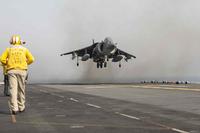The Navy’s 2015 budget request leaves the fate of its eleventh aircraft carrier up in the air and massively reduces five year acquisition plans for the carrier variant of the Joint Strike Fighter.
Overall, the Navy’s budget request is for $148 billion, a $38 billion decrease over a projected five-year period when compared with last year’s budget request.
The 2015 budget breaks down with $45 billion for personnel, $46 billion for operations and maintenance, $38 billion for procurement, and $16 billion for research and development, said Rear Adm. William Lescher, the Navy’s budget director.
If sequestration resumes in fiscal year 2016 as is the stipulation of the Budget Control Act of 2011, there would be an additional $39 billion reduction for the Navy, Lescher said.
The service estimates that these sequester reductions would require inactivation of a carrier, decommissioning of an air wing and decreasing in the size of the Marine Corps to 175,000, he said. In addition, the cuts would lead to the removal of six surface combatants from service and the elimination of the planned purchase of three DDGs, a submarine and other platforms, he said.
The Navy’s five-year plans to acquire the F-35C dropped substantially from a fiscal year 2014 plan to buy 69 to a 2015 proposed plan to buy 36. Plans to acquire the Marine Corps variant, however, the short take-off-and-landing F-35B, have not changed. The Navy’s 2015 budget proposal requests for the service to purchase 69 F-35B between 2015 and 2019.
Although budget pressures are driving the decrease in planned acquisitions of the Navy’s F-35C, service officials say the procurement numbers are expected to rise again in coming years.
“Affordability is driving this. However, the plan is to ramp up again as we get closer to the JSF F-35C IOC (initial operating capability) in 2019,” a Navy officials said.
At the same time, the 2015 budget request does not make the determination as to whether there will be mid-life refueling funds for the services’ USS George Washington.
“This next year will give us an idea of whether or not we get to keep the carrier,” a Navy official said.
Budget pressures have lead the Navy to considering retiring the USS George Washington, a Nimitz-class aircraft carrier slated to go through mid-life refueling and overhaul over the next several years. While carriers typically serve for as long as 50 years, with 25 of them after the mid-life refueling – there has been discussion about whether the George Washington will retire at its half-way point, thus lowering the total number in the fleet to 10.
Service leaders have said that if, as is currently the case, sequestration returns in 2016 – then there will not be sufficient funds to re-fuel the USS George Washington and the carrier will be retired. Refueling can cost anywhere between $4 and $6 billion.
Acquisition of the Navy’s P-8A surveillance and anti-submarine aircraft has been decreased by eight aircraft in the 2015 budget. The budget asks for funds to procure eight aircraft in 2015, less than what was planned for in fiscal year 2014. Affordability constraints were cited as the reason for the decrease.
Meanwhile, the 2015 budget proposal supports the acquisition of MV-22 Osprey helicopters, calling for 19 of them in 2015 and 2016, and 18 in 2017. The tilt-rotor aircraft is used in Afghanistan and on amphibious assault ships and other assets to ferry mission-essential troops and supplies. In total, the service is looking to acquire 64 of the aircraft over the next five years.
Funding for submarines, destroyers and some UAS remain steady, according to the Navy’s budget request. The proposal asks for $5.8 billion to fund the continued construction of two Virginia-class submarines per year and $2.8 billion for DDG-51 destroyers. The service is requesting $1.4 billion for its Littoral Combat Ship, a program which has been reduced from 52 overall ships to 32.
The request also includes $1.3 billion for the next Ford-class aircraft carrier now in development, the USS Enterprise (CVN 80).
The budget includes a requested $1.2 billion for the Ohio Class replacement program, a next-generation nuclear-armed submarine being developed to replace the existing Ohio-class submarines and provide nuclear deterrence.
The Navy’s MQ-4C Triton UAS is heavily supported throughout the services’ five year plan, however procurement of the system has been delayed, Lescher said. The 2015 budget proposal calls for the acquisition of four Triton’s per year through 2019 beginning in 2016.
The U.S. Navy is preparing to house its first squadron of MQ-4C Triton drones in Guam by the end of 2017, service officials said.
On the weapons front, the 2015 budget proposal supports another multi-year deal for the Evolved Sea Sparrow Missile, or ESSM, a surface-to-air ship self-defense missile system. The Navy plans to acquire 502 ESSMs over the next five years, putting them on destroyers, aircraft carriers and amphibious assault ships. The budget also supports restarting production of the Mk-48 advanced capability heavyweight torpedoes fired by submarines.
In terms of proposed dollar allocations for weapons systems, the 2015 request asks for $1.1 billion for Trident II modifications, $119 million for ESSM, $194 million for Tomahawk missiles and $47 million for M-48 torpedo modifications.








